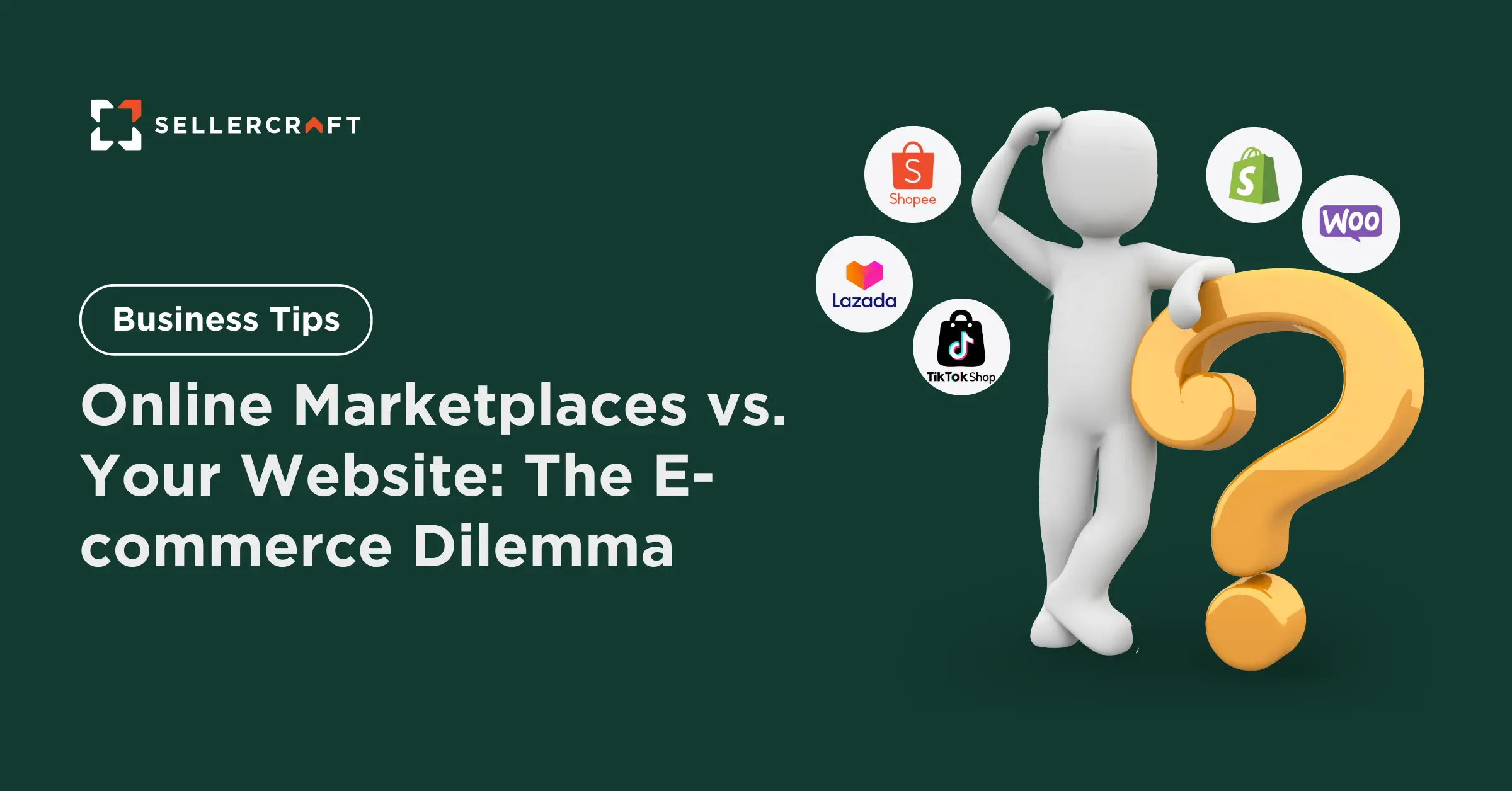
Businesses entering the ecommerce sector have a crucial decision: whether to take advantage of a digital marketplace such as Shopee, TikTok Shop, Lazada, or Zalora, or to invest in creating and managing their own exclusive website either from scratch or Shopify, and Woocommerce. Choosing where to sell things online has an enormous effect on a business's long-term strategic orientation. Let's thoroughly examine this channel dilemma to assess the pros and cons of each choice.
The Appeal of Online Marketplaces
A marketplace platform is a comprehensive online marketplace that features products from a variety of merchants. It functions similarly to a digital shopping mall, allowing customers to access a diverse range of items from numerous merchants, concluding in a simple checkout process for enhanced convenience.
Shopee, TikTok Shop, Lazada, and Zalora are a few well-known marketplaces that allow merchants to reach a large audience. These established platforms put safety and functionality first for both merchants and buyers, providing secure transactions and user-friendly interfaces. These marketplaces make money by charging commissions or subscription fees.
Let’s take a closer look at the pros and cons of selling on marketplaces:
Pros of Selling on an Online Marketplace | Cons of Selling on an Online Marketplace |
|---|---|
|
|
Digital marketplaces offer several advantages that make them enticing for ecommerce entrepreneurs:
Pros of Selling on an Online Marketplace:
Large Audience: Marketplaces feature millions of active users, allowing access to a large prospective client base without requiring costly marketing efforts.
Established Infrastructure: Marketplaces manage critical areas of ecommerce, such as payment processing, order fulfillment, and customer service, easing the burden on sellers.
Brand Visibility: New businesses can benefit from existing marketplaces' visibility, which makes it easier to attract customers and grow brand recognition.
Trust and Credibility: Buyers often trust well-known marketplaces, which can lead to increased sales and a positive reputation for your products.
Marketing Opportunities: Marketplaces may offer advertising services and promotional tools to help sellers boost visibility and sales.
Ease of Entry: Setting up a seller account on a marketplace is relatively quick and straightforward, requiring minimal technical expertise.
Cons of Selling on an Online Marketplace:
Competition: Marketplaces are crowded with numerous sellers offering similar products, making it challenging to stand out and differentiate your brand.
Fee Structure: Marketplaces typically charge various fees, including transaction fees, and commissions on sales, which can eat into profit margins.
Limited Control: Sellers have limited control over branding, customer communication, and customization of the shopping experience on a marketplace.
Dependency on Platform: Changes in marketplace policies or algorithms can impact sellers' visibility and sales, leading to uncertainties.
Lack of Customer Data: Marketplaces often restrict access to customer data, making it harder for sellers to build direct relationships and market to their customer base.
Brand Dilution: Selling alongside competitors can dilute your brand identity and reduce the perceived value of your products.
Selling on an online marketplace can provide rapid access to customers and streamline operations, but it may also provide issues in terms of competition, costs, and control over the selling process. Sellers have to evaluate these issues against their long-term business objectives and strategy.
The Strengths of Owning A Website
Creating your own online store frees you from shared digital platforms. This approach opens up endless customisation and branding opportunities, allowing you to create a one-of-a-kind storefront that reflects your brand identity and provides customers with a personalized online buying experience.
When entering the market for e-commerce or developing an online business presence, there are numerous factors to consider, including prices, time commitments, functionality, and scalability. Operating a website with an e-commerce platform requires more time commitment than using an online marketplace, particularly in the early stages of development.
If you value remarketing advertising, personalized customer service, and a solution tailored to your specific business needs, platforms such as Shopify, Magento, or WooCommerce are excellent choices for creating and administering your e-commerce website.
Let’s take a closer look of pros and cons to own and operate your own ecommerce website:
Pros of Selling on Your Own E-commerce Website | Cons of Selling on Your Own E-commerce Website |
|---|---|
|
|
Pros of Selling on Your Own E-commerce Website:
Brand Control: You have complete control over your brand's presentation, messaging, and customer experience, allowing you to build a unique identity.
Customization: You can customize every aspect of your website, including design, layout, and functionality, to suit your business needs and customer preferences.
Direct Customer Relationships: Selling on your own website allows you to interact directly with customers, gather valuable data, and build long-lasting relationships without intermediary restrictions.
Higher Profit Margins: You retain more of your revenue since you're not paying fees or commissions to a third-party marketplace.
Flexibility: You have the flexibility to implement your own marketing strategies, promotions, and sales tactics to drive business growth.
Scalability: You can scale your website and operations according to your business's growth trajectory without limitations imposed by a third-party platform.
Cons of Selling on Your Own E-commerce Website:
Initial Investment: Setting up and maintaining your own ecommerce website can require a significant upfront investment in terms of development, design, and infrastructure.
Technical Expertise: Managing your website involves technical aspects such as hosting, security, and maintenance, which may require specialized knowledge or hiring external help.
Marketing and Traffic: Unlike marketplaces with built-in traffic, driving visitors to your own website requires robust marketing efforts, SEO optimization, and possibly paid advertising.
Trust and Credibility: Establishing trust and credibility for a new website can be challenging compared to selling on established marketplaces with existing customer bases.
Payment Processing: You'll need to set up and manage your own payment processing system, including handling transactions securely and resolving payment-related issues.
Customer Acquisition Costs: Acquiring new customers can be more costly when relying solely on your own website, especially in the initial stages of business.
Selling on your own ecommerce website provides autonomy and flexibility, but it necessitates careful consideration of prices, technological needs, and marketing strategies. To make an informed selection, evaluate these aspects in relation to your business objectives and resources.
Choosing the Right Path
Ultimately, the decision between a digital marketplace and your own website depends on various factors including your business goals, budget, and target audience. Many successful ecommerce businesses employ a hybrid approach, leveraging both channels to maximize reach and revenue.
Marketplace | Dedicated Website |
|---|---|
|
|
Key Considerations for Decision-Making
Choosing the best approach between using a marketplace and creating your own dedicated ecommerce website requires careful consideration of various criteria. Here are some essential considerations to assist you make your decision:
Business Goals and Long-Term Strategy
Define your business objectives and analyze how each technique fits into your long-term growth strategies. Determine whether you want to create a recognisable brand with complete control over the consumer experience (dedicated website) or prioritize quick market access and sales (marketplace).
Target Audience and Market Reach
Understand your target audience and where they like to shop online. Determine which platform (marketplace or dedicated website) will help you reach and engage those who are your ideal customers
Control and Branding
Determine what level of control you want over branding, design, and customer interactions. Decide whether you need the ability to customize your web presence to suit your distinct brand identity.
Costs and Budget
Compare the initial setup costs and continuing expenses for every approach. Consider platform fees, development costs, marketing charges, and administrative overhead.
Technical Expertise and Resources
Assess your team's expertise and the resources available for website development, maintenance, and advertising. Determine whether you need specialized expertise to operate and optimize a dedicated website.
Customer Data and Relationships
Consider the value of owning customer data and developing direct interactions with your audience. Determine whether having control over customer interactions and communications is vital to the success of your company.
Scalability and Growth Potential
Determine the scalability of each technique based on your expected growth trajectory. Consider how easily you may expand your product options, improve performance, and respond to changing market demands.
Marketplace Dynamics and Competition
Research the exact marketplace you're targeting and determine the level of competition in your product category. Determine the advantages and disadvantages of selling alongside competitors in a marketplace.
Marketing and Promotion
Evaluate the marketing tools and capabilities provided by every approach. Determine which platform offers the most support for launching promotional campaigns, SEO methods, and client acquisition tactics.
Shifting From Selling on Online Marketplaces to Running Your Own Dedicated E-commerce Website?
Many businesses choose to start on a marketplace to leverage its existing customer base and infrastructure before expanding to their own ecommerce website. However, making this transition also requires important steps and considerations:
Assess Business Readiness
Determine whether your business is ready for the change based on factors such as brand recognition, customer loyalty, product range, and revenue stability.
Brand Identity
Develop a distinct brand identity, comprising a compelling brand story, logo, and visual elements, to distinguish your products/services from competition.
Import Products and Inventory
Transfer product listings and inventory data from the marketplace to your website, ensuring accurate descriptions, images, and pricing.
Implement Marketing Strategies
Develop and execute a marketing plan focused on driving traffic to your new website. Use SEO, social media, email campaigns, and content marketing to attract and engage customers.
Communicate with Customers
Inform current customers about your new online store using email newsletters, social media, and marketplace messaging. Encourage them to visit your website for unique deals.
Optimize User Experience
Make sure your website provides a top-notch user experience by incorporating smooth navigation, quick loading speeds, mobile-friendly design, and compelling calls-to-action to boost conversions.
Key Factors for Success: Selling in Both Approach, Marketplaces and Website
Operating on both an online marketplace and your own e-commerce website requires careful consideration of key factors to ensure success.
Product Selection
Evaluate which products are best suited for each platform. Consider factors such as product demand, competition, and pricing strategy. This can be easily done with a Data & Analytics tool which does not require you to monitor this data manually. You can access valuable insights through powerful analytics tools to make data-driven decisions, optimize performance, and identify sales opportunities.
Brand Consistency:
Maintain consistent branding across all channels to reinforce your brand identity and build trust with customers. Use consistent imagery, messaging, and tone of voice.
Inventory Management
Use an effective inventory management solution, such as to properly track stock levels across different platforms and avoid overselling by syncing inventory in real time. With Sellercraft's centralized inventory control, you can keep track of stock levels across all channels, maximizing revenues by efficiently restocking popular items and managing inventory properly.
Order Fulfillment
When developing your order fulfillment strategy, use a dependable approach that can manage orders from different channels. If necessary, consider using third-party logistics (3PL) services to increase efficiency. Make use of Sellercraft Order Management to efficiently process orders from multiple marketplaces, using optimized fulfillment processes to ensure fast and accurate order processing.
Data Analysis
Utilize analytics tools to monitor performance metrics (e.g., sales, conversion rates, dropping sales, top SKUs) on each platform. Use data insights to optimize strategies and improve ROI.
Technology Integration
Opt for ecommerce platforms and tools that seamlessly integrate with each other, including inventory management systems, marketing automation tools, and custom API integrations. Sellercraft offers tailored API integrations to legacy systems, allowing you to connect existing processes with Sellercraft's platform for a seamless digital transformation without disruption.
Conclusion
Last but not least, deciding between selling on an online marketplace and running your own ecommerce website requires considering a variety of aspects that are relevant to your business goals, resources, and target audience. Each approach has unique advantages and disadvantages.
Additionally, the decision should be consistent with your long-term business strategy and objectives. Many successful ecommerce businesses take a hybrid approach, using both online marketplaces and dedicated websites to increase reach, brand control, and profitability. Transitioning from marketplaces to your own website necessitates thorough preparation, which includes assessing brand maturity, creating a unique brand identity, optimizing user experience, and integrating efficient inventory and order management systems.
By taking into account crucial elements such as business goals, target audience, branding control, expenses, technological resources, scalability, and marketing skills, you can make an informed decision that corresponds with your business vision and maximizes ecommerce success.


